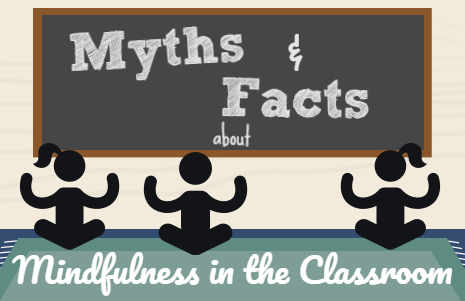By Lisa Carey and Jonathan Schmidt, Ph.D.
August 29, 2017

Mindfulness is intention awareness of one’s self and surroundings. To practice mindfulness is to experience the current moment and take a break, even very briefly, from reacting to the world around you and worrying about the past or future.. As conversations surrounding the use of mindfulness in the classroom increase, we thought we’d take some time to debunk some common myths about using mindfulness in schools.
Myth: Mindfulness lacks evidence and research and therefore shouldn't be used in the classroom.
Fact: There is an extensive amount of research on the utility of mindfulness practices for decreasing symptoms of stress, anxiety, depression, and improving pro-social behavior such as empathy, perspective taking, and attention.
Myth: Mindfulness and other social-emotional learning trends take time away from the curriculum.
Fact: Mindfulness strategies can be easily built into the curriculum. Remember, it just involves a moment to moment awareness of what you are experiencing, without judgment. These aspects can be built into the curriculum naturally, and thus potentially enhance the student’s experience.
Myth: Teachers can't use mindfulness if they haven't attended expensive trainings.
Fact: You can incorporate some mindfulness techniques into your classroom without attending expensive trainings. However, commensurate with any practice, you should be sure to only practice within your limits. Thus, teachers should not be practicing in-depth meditation sessions, or processing trauma or addressing mental health issues using mindfulness procedures in the classroom. Rather, simple guided breathing exercises can be accessible to all levels of practitioner.
For more information about free guided breathing resources, check out our digital resource round-up blog post. Whenever possible, be sure to consult with a professional who has experience using mindfulness techniques to determine what will be most appropriate for your setting. While attending trainings can help, many meditation centers offer low-cost options to community members who wish to learn more about mindfulness and medication.
Myth: Mindfulness is for just for kids who have experienced trauma or have significant behavioral problems.
Fact: Everyone can benefit from a little mindfulness! It offers a way for you to be present with your experiences, and some good attitudinal principles for how to approach life, and interactions with others. For individuals with trauma, and depending on the significance of the behavior problems being exhibited, it may be more appropriate to refer or consult with a mental health professional.
Myth: It takes too much time for busy teachers to learn mindfulness.
Fact: Well, that is a great reason to practice mindfulness! Mindfulness has been shown to decrease the negative impacts of stress. Practicing mindfulness won’t just allow you to use it with your students; it will most likely positively impact your ability to deal with the immense stress of being a teacher. Of course, many people choose to deepen their practice in mindfulness by studying extensively, taking courses, attending conferences, etc. However, people need to only do as much as is appropriate for themselves and their current goals. Simple and short exercises are available free online.
While exciting, teaching and learning within a school community can also be stressful. Interest in using mindfulness within the educational setting is growing, as is the body of research supporting its use to decrease toxic stress and increase pro-social behavior. Hopefully, you are able to take some pieces of mindfulness into your daily instructional practice to help both you and your students enjoy the school year and reduce your reactivity to stressors that detract from the learning process.
References:
Harpin, S. B., Rossi, A., Kim, A. K., & Swanson, L. M. (2016). Behavioral impacts of a mindfulness pilot intervention program for elementary school students. Education, 137(2), 149-156.
Harris, K. I. (2017). A Teachers Journey to Mindfulness: Opportunities for Joy, Hope, and Compassion. Childhood Education, 93(2), 119-127.
Hofmann, S. G., Sawyer, A. T., Witt, A. A., & Oh, D. (2010). The effect of mindfulness-based therapy on anxiety and depression: A meta-analytic review. Journal of consulting and clinical psychology, 78(2), 169.
Meiklejohn, J., Phillips, C., Freedman, M. L., Griffin, M. L., Biegel, G., Roach, A., . . .Saltzman, A. (2012). Integrating Mindfulness Training into K-12 Education: Fostering the Resilience of Teachers and Students. Mindfulness, 3(4), 291-307.
Moreno, A. J. (2017). A Theoretically and Ethically Grounded Approach to Mindfulness Practices in the Primary Grades. Childhood Education, 93(2), 100-108.
Semple, R. J., Lee, J., Rosa, D., & Miller, L. F. (2010). A randomized trial of mindfulness-based cognitive therapy for children: Promoting mindful attention to enhance social-emotional resiliency in children. Journal of Child and Family Studies, 19(2), 218-229.















